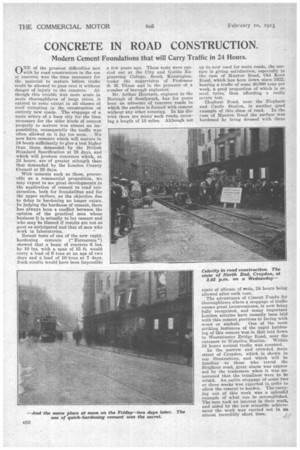CONCRETE IN ROAD CONSTRUCTION.
Page 46

If you've noticed an error in this article please click here to report it so we can fix it.
Modern Cement Foundations that will Carry Traffic in 24 Hours.
ONEof the greatest difficulties met with by road constructors in the use of concrete was the time necessary for the material to mature Wore traffic could be allowed to pass over it without danger of injury to the concrete. Although this trouble was more acute in main thoroughfares of large cities, it existed to some extent in all classes of road excepting in the construction of entirely new roads. The stoppage of a main artery of a busy city for the time necessary for the older kinds of cement properly to mature was almost an impossibility, consequently the traffic was often allowed on it far too soon. We now have cements which will mature in 24 hours sufficiently to give a test higher than those demanded by the British Standard Specification at 28 days, and which will produce concretes which, at 24 hours, are of greater sti-ength than that demanded by the London County Council at 28 days.
With cements such as these, procurable as a commercial proposition, we may expect to see great developments in the application of cement to road construction, both for foundations and for the upper surface, as the objection due to delay in hardening no longer exists. In judging the hardness of cement, there has always been a conflict between the opinion of the practical men whose business it is actually to lay cement and who may be blamed if results are not as good as anticipated and that of men who work in laboratories.
Recent tests of one of the new rapidhardening cements (" Ferrocrete") showed that a beam of concrete 6 ins. by 10 ins. with a. span of 15 ft. would carry a load of 6 tons at an age of two days and a load of 10 tons at 7 days. Such results would have been impossible a few years ago. These tests were carried out at the City and Guilds Engineering College, . South Vensington, under the supervision of Professor S. M. Dixon and in the presence of a number of borough engineers.
Mr. Arthur Harrison, engineer to the Borough of Southwark, has for years been an advocate of concrete roads in which the surface is formed with cement without any other covering. In his district there are many such roads, covering a length of 10 miles. Although not up to now used for main roads, the surface is giving satisfaction, especially in the ease of Miniton Road, Old Kent Road, which has been down since 192, bearing a traffic of some 20,000 tons per week, a good proPortion of which is on steel tyres; thus affording a really severe test.
Elephant Road, near the Elephant and Castle Station, is another good example of this class of road. In the ease of Minton Road the surface was hardened by being dressed with three coats of silicate of soda, 24 hours being allowed after each coat. The advantages of ()intent Fondu for thoroughfares where a stoppage of traffic causes great inconvenience, is now being fully recognized, and many important London arteries have recently been laid with this cement previous to facing with wood or asphalt. One of the most striking instances of the rapid hardening of this cement was in that laid down in Westminster Bridge Road, near the entrance to Waterloo Station. Within 24 hours normal traffic was resumed.
In the narrow and crowded main street of Croydon, which is shown in our illustrations, and which will be familiar to those who travel the Brighton road, great alarm was expressed by the tradesmen when it was announced that the tramlines were to be relaid. An entire stoppage of some two or three weeks was expected in order to allow the cement to harden. The carrying out of this work was a splendid example of what can be accomplished. The men took an interest in their work, and aided by the new scientific achievement the work was carried out in an almost incredibly short time.














































